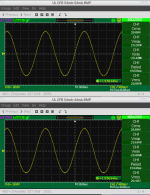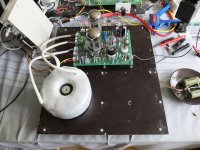That's an actual tube OPT, right? I've been talking about using power transformers as OPTs so in my experience they can tolerate more imbalance. Still, that doesn't look bad given the frequency and almost 20% misbalance. What's the DCR of primary?
That, or you could use them as heater transformers 🙂
Ha! Yeah, I suppose I could. This amp only needs 3A heater current total, and I don't have anything planned that needs 8A+, but I'll bet I could come up with something ...
Here is an oscillogram of 2 setups with the toroidal output transformer, fully balanced 55mA idle current (top), and 54mA / 44mA imbalance (bottom), 20V RMS on 8 Ohm. Differences can be found with a spectrum analyzer.
Can you help me understand what I'm looking at? I don't see any difference at all - same swing peak to peak, 2% difference in RMS, waveforms seem visually identical. Am I missing something? Does this show up on the spectrum analyzer as something more dramatic?
For my use case, I'm not targeting perfectly clean sound. THD is going to be swamped by the relatively crappy speakers, the poorly-treated L-shaped room with multiple troublesome modes, and ears that have spent far too many hours in front of cranked guitar amps.
Last edited:
Can you help me understand what I'm looking at? I don't see any difference at all - same swing peak to peak, 2% difference in RMS, waveforms seem visually identical.
It is written clearly in my post - an oscillogram of 2 setups with the PP toroidal output transformer, fully balanced 55mA idle current (top), and 54mA / 44mA imbalance (bottom), 20V RMS on 8 Ohm.
It means output toroids CAN tolerate a typical imbalance if are designed to do so with no core saturation.
I had spectrum analyzer graphs when tested but it lost, trashed some pieces of my digital archive a long time ago.
That's an actual tube OPT, right? I've been talking about using power transformers as OPTs so in my experience they can tolerate more imbalance. Still, that doesn't look bad given the frequency and almost 20% misbalance. What's the DCR of primary?
Yes, real tube output transformer. DCR was about 100 - 120 Ohm, I had several different prototypes.
BTW, I wouldn't suggest using generic power toroids for audio output, this is not a good idea from any angle.
It's more fetish rather than sound reason (actually the whole audio output toroid story no matter of product origin).
Last edited:
It is written clearly in my post
Sorry, I couldn't tell whether you were showing that it was a bad idea, or that it wasn't a big deal! Appreciate the clarification.
Impressive!
50 Watts into 8 Ohms at 20Hz.
A microphone to the scope, and most woofers at 50 Watts and 20Hz will not look that good.
50 Watts into 8 Ohms at 20Hz.
A microphone to the scope, and most woofers at 50 Watts and 20Hz will not look that good.
Sorry, I couldn't tell whether you were showing that it was a bad idea, or that it wasn't a big deal! Appreciate the clarification.
Technically possible to make output toroid good from all aspects, incl. immunity to moderate DC imbalance (Achilles' heel of that kind), yet the same can be achieved with classic C-Core, less time consuming + lower cost.
So, if we drop the fetish factor out of the picture, output toroid is not a big deal.
For power unit or air-gapped choke, it makes sense because of the lower leakage inductance and hum induced into an amplifier.
Last edited:
Yeah. It was different though a while ago. There used to be a supplier with a nice catalog of C-cores, and their retail prices were very affordable. I bought two 6-pound cores for $25 ea, including bobbins and mounting hardware. They also had square magnet wire. They are still in business, but now only sell crossover parts.
Koda - I was thinking of your two-transformer scheme, and came to realize that it has more merit than I originally thought. The issue is inductance. It may be counterintuitive, but smaller toroids have higher inductance compared to big ones, with the same number of turns. In my case with 3 kVA core, 50 H half-primary has 1,700 turns. A 25 VA toroid may have 50 H half primary (120 V) with only 1,200 turns, translating in lower primary DCR. Two transformer combo will have 100 H half-primary or 400 H whole, which are very good numbers that cannot be practically achieved with one big core.
The advantage of the bigger core is in power handling. Two 25 VA cores can handle 20 W at 20 Hz at the onset of saturation. A 3 KVA can handle 1 kVA at 20 Hz. My amplifier is 150 W at the onset of clipping, so the transformer has a little bit of headroom.
The advantage of the bigger core is in power handling. Two 25 VA cores can handle 20 W at 20 Hz at the onset of saturation. A 3 KVA can handle 1 kVA at 20 Hz. My amplifier is 150 W at the onset of clipping, so the transformer has a little bit of headroom.
- Home
- Amplifiers
- Tubes / Valves
- PP toroidal OPT - how critical is DC balance?

